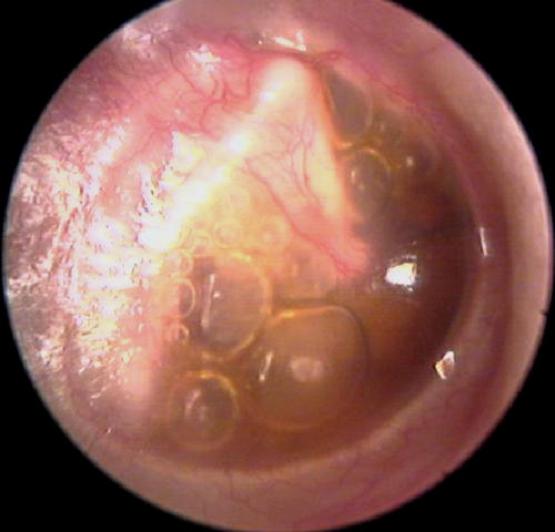Reasons | Clinic ESO | Diagnostics | Treatment of exudative otitis media

Exudative otitis media (EMI) is a disease in which an accumulation of pathological fluid (exudate) is found in the middle ear cavity against the background of its inflammation. Most often, exudative otitis media is a continuation of acute otitis media, when there is no adequate therapy for the latter.
You can diagnose and treat exudative otitis media (ESO) in the Department of Otorhinolaryngology K + 31.
For exudative otitis media, in most cases, vivid symptoms are not characteristic, which creates a high probability of its transition into a more severe form of adhesive (adhesive) otitis media.
Causes
The tympanic cavity is expelled by a layer of epithelial cells that continually produce small amounts of fluid. Normally, the excess of this fluid is removed into the nasal cavity through the auditory tube, the violation of the drainage function of which is the main cause of exudative inflammation of the middle ear. The outflow of fluid can be impeded by:
- Diseases of the auditory tube itself;
- Untreated acute otitis media with persisting edema;
- Swelling of the lining of the nose where the auditory tube opens (rhinitis);
- Mechanical obstruction to outflow (adenoids, benign tumors, curvature of the nasal septum);
Certain medical interventions in the nasal cavity (plastic septum and concha, removal of tumors, tamponade of the nasal cavity) can also lead to the accumulation of exudate in the ear.
Clinic ESO
Otitis media with effusion has four main stages:
- Catarrhal;
- Secretory;
- Mucous;
- Fibrous.
The catarrhal stage of exudative ear inflammation in its symptoms is very similar to the clinical picture of classical acute otitis media . Some experts consider these concepts to be identical.
With the onset of the secretory stage, the activity of inflammation fades away, however, the persisting edema of the auditory tube prevents the normal outflow of fluid from the middle ear, which leads to the accumulation of exudate in the latter.
At this stage, the symptoms of inflammation practically disappear. There is practically no pain, or they occur periodically. The patient is more worried about constant ear congestion, hearing loss, unusual feeling of his own voice and fluid movement in the ear.
Approximately 12 months after the onset of inflammation, the exudate loses its liquid component, becomes more viscous and thick - this is the mucous stage of the ESP . During this period, the main symptom is a pronounced hearing loss, tinnitus is possible.
The final stage is fibrous (degenerative), which develops 2 years after the onset of the disease.
Diagnostics
Given the meager range of symptoms of exudative otitis media, during the initial visit, the otorhinolaryngologist pays special attention to questioning the patient. During the conversation, all previous infectious and inflammatory diseases of the ears and nasopharynx, allergies, and medical procedures performed are specified. Further, a number of objective studies are carried out, without which it is practically impossible to make a correct diagnosis.
In an otoscopy (otomicroscopy), the eardrum, which may be cloudy, bluish, and limited in mobility, is examined. At the secretory stage, a level of fluid is noted through the eardrum, and the membrane itself becomes convex. With the onset of the mucosal and fibrinous stage, the membrane flattens and retracts. Additional studies of the tympanic membrane are carried out for its mobility using tympanometry, Valsalva tests. To clarify the nature of the exudate, a puncture (puncture) of the tympanic membrane is performed with a syringe with a thin needle.
Diagnostics of hearing acuity is carried out with tuning forks, audiometry. Acoustic reflexes are studied - the reaction of the ear (external and middle parts of it) to loud sounds.
We keep the health of patients in focus and in difficult cases, when it is not possible to establish an accurate diagnosis with simpler methods, we recommend performing computed or magnetic resonance imaging. This allows you to accurately determine the volume of fluid, the degree of damage to the small structures of the middle ear, and sometimes the immediate cause of EOS.
To visualize the outlet of the auditory tube, endoscopic examination of the nasopharynx is performed (search for adenomas, tumors).
Treatment of exudative otitis media
The therapy of exudative otitis media begins with the elimination of swelling of the mucous membrane of the upper respiratory tract (nose) and the auditory tube. In this case, vasoconstrictor drops are used for instillation into the nose, mucolytics (agents that thin mucus), antiallergic drugs. In the presence of rhinitis, sinusitis - anti-inflammatory and antibacterial drugs.
The mechanical nature of EOS is an indication for surgical intervention (plastic surgery of the nasal septum, removal of tumors, etc.).
With the ineffectiveness of conservative treatment and surgical interventions, the auditory tube is blown out, the fluid is completely removed during puncture of the tympanic membrane, in severe cases, the tympanic cavity shunting, which prevents the accumulation of new fluid, increases the effectiveness of conservative therapy, reduces the risk of developing adhesive otitis media and allows you to maintain health For you.
